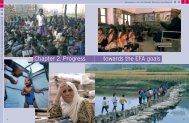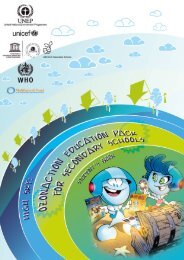Financing Education / pdf - Unesco
Financing Education / pdf - Unesco
Financing Education / pdf - Unesco
You also want an ePaper? Increase the reach of your titles
YUMPU automatically turns print PDFs into web optimized ePapers that Google loves.
2<br />
0<br />
8<br />
0<br />
CHAPTER 4<br />
<strong>Education</strong> for All Global Monitoring Report<br />
Some countries<br />
and donors have<br />
approached the<br />
compact made<br />
at Dakar within<br />
the framework<br />
of the FTI<br />
In addition, in contrast to the 1990s, the notion of<br />
partnership refers less to the expansion of a service<br />
delivery role and more to the importance of civil<br />
society participation in the formulation of national<br />
education sector policies. Donor organizations<br />
increasingly refer to the role civil society can play<br />
in holding governments accountable.<br />
On the other hand, the new call for partnership is<br />
not always straightforward. Governments clearly<br />
seek ways to manage and sometimes limit civil<br />
society participation in policy deliberations and<br />
to use organizations to legitimize rather than to<br />
influence the content of sector plans. Tensions<br />
and challenges arise particularly out of the dual<br />
advocacy/service-delivery role now expected from<br />
civil society organizations.<br />
The report card for donors is mixed. Overall, aid for<br />
basic education has been increasing and has been<br />
marginally better targeted to low-income counties.<br />
The doubling of aid by some donors is impressive.<br />
Yet, in spite of the increase, aid to basic education<br />
represents only 6% of sector-allocable aid and<br />
one-third of the DAC donors have actually reduced<br />
aid to basic education since 1999–2000.<br />
The message from Dakar was that if a government<br />
demonstrated commitment to basic education,<br />
donors would respond. A country-by-country<br />
assessment of the extent to which this has<br />
occurred is limited, as the contribution of aid to<br />
total expenditure on education in 1999 and 2005<br />
is known for only twenty-one least developed<br />
countries. For this group the share of aid in total<br />
expenditure in both years was 11%, showing that<br />
increases in aid closely kept pace with increases<br />
in domestic expenditure. However, it is clear that<br />
the situation regarding domestic expenditure on<br />
education and the amounts of aid received vary<br />
greatly by country.<br />
Some countries and donors have approached the<br />
compact made at Dakar within the framework of<br />
the FTI. As of August 2007, thirty-two countries had<br />
developed education sector plans that local donor<br />
representatives had endorsed. Not all low-income<br />
countries have adopted this route for attracting<br />
more aid; for instance, large countries such as<br />
Bangladesh, India and Pakistan have not. However,<br />
many countries in sub-Saharan Africa and Central<br />
America have joined the FTI. While no causal<br />
relationships can be drawn between being an<br />
endorsed FTI country and having increased the<br />
Figure 4.18: Changes in the share of GNP devoted<br />
to education in twenty-one FTI-endorsed countries,<br />
1999—2005<br />
Gambia<br />
Nicaragua<br />
Mauritania<br />
Cameroon<br />
Mongolia<br />
Guyana<br />
Rep. of Moldova<br />
Guinea<br />
Niger<br />
Lesotho<br />
Madagascar<br />
Kyrgyzstan<br />
Cambodia<br />
Benin<br />
Ghana<br />
Mozambique<br />
Mali<br />
Kenya<br />
Tajikistan<br />
Senegal<br />
Ethiopia<br />
-1.0 -0.5 0.0 0.5 1.0 1.5 2.0 2.5<br />
1999–2005 change (percentage points)<br />
Source: Annex, Statistical Table 11.<br />
priority for education sector domestic funding,<br />
it is interesting to see what happened to funding<br />
for education in these FTI countries between 1999<br />
and 2005. Data are available for twenty-one of<br />
the thirty-two countries (Figure 4.18).<br />
The share of education in GNP increased in<br />
fourteen of these countries and fell in seven. Of the<br />
former group, the increase was equal to 1% of GNP<br />
or more in nine countries. Of the seven countries<br />
where the share fell, it did so by more than 1% in<br />
only one case. However, it is somewhat surprising<br />
that the share would fall in any of these countries.<br />
Figure 4.19 compares annual growth rates in<br />
domestic expenditure on education in thirty-two<br />
low-income countries with annual growth rates in<br />
aid to education between 1999 and 2005, to assess<br />
whether increased domestic spending has moved<br />
broadly in tandem with higher aid growth rates.<br />
While there is no necessarily causal effect and<br />
there are several outliers, this appears to be the<br />
case in most countries, particularly those with<br />
endorsed FTI plans, providing some tentative<br />
support to the notion that external financial<br />
resources, while still very limited, are beginning<br />
to move in the direction anticipated at Dakar.<br />
Since 2000 there has been a global acceleration<br />
in financial commitments made to EFA by both<br />
174

















